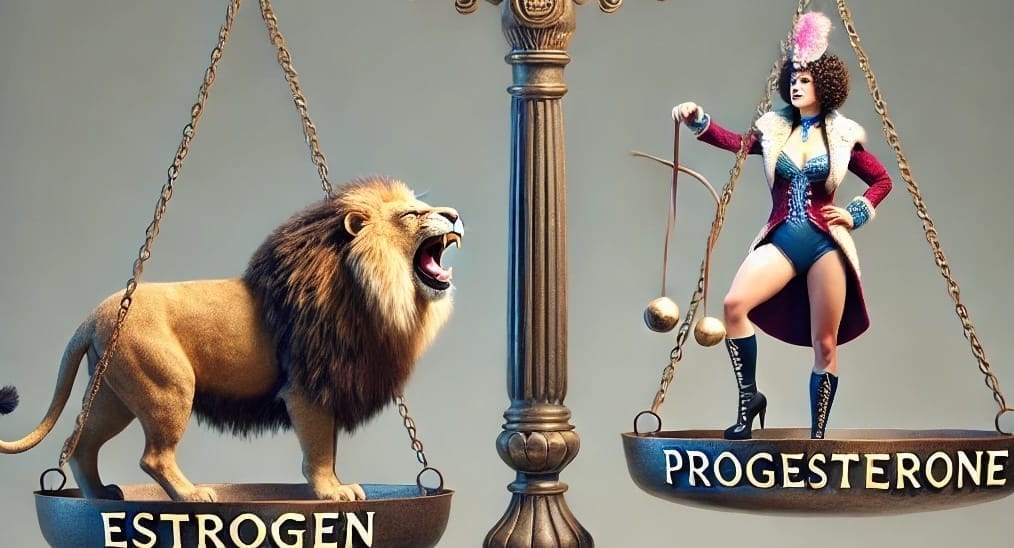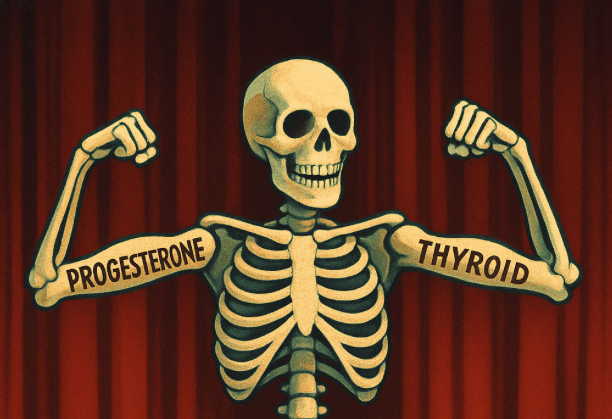Estrogen for skin?!
Estrogen is marketed as the ultimate beauty hormone—glowing skin, fewer wrinkles, plump cheeks, and collagen for days.
But there’s a lesser-known truth: Too much estrogen, the wrong kind, or poor estrogen metabolism can make your skin worse—not better.
And that cream your doctor told you was “just local”?
Yeah… it’s not.
Let's expose two big myths:
1. That estrogen is always your skin’s best friend
2. That topical estrogen stays "local"
Let’s set the record straight with a little science and a lot of common sense.
PART 1: THE ESTROGEN AND SKIN MYTH
Estrogen can support hydration, elasticity, and collagen—but only when it’s balanced by its co-star: progesterone.
When estrogen is unopposed or poorly metabolized, it creates the following skin issues:
Skin Toughness and Hardening
Promotes collagen cross-linking, making skin rigid and less elastic.
Fibrosis and Leathery Skin
Overstimulates fibroblasts, leading to excessive dense, fibrotic tissue.
Poor Wound Healing
Triggers inflammation, disrupting regeneration and promoting scar tissue.
Wrinkles and Premature Aging
Slows down collagen turnover and lowers metabolic rate.
PART 2: WHY THIS HAPPENS
Estrogen isn’t evil. But without proper metabolism via the liver and gut—and without progesterone or thyroid hormone to balance it—it becomes inflammatory and fibrotic.
Your skin pays the price in the form of:
Sluggish renewal
Thickened connective tissue
Dehydration
Dullness and irritation
Footnote 1: Estrogen dominance increases cytokines like TGF-beta, a key driver of fibrosis and aging skin.
PART 3: WHAT KEEPS SKIN YOUTHFUL AND HEALTHY?
Progesterone
Calms fibroblasts, opposes estrogen, and supports collagen renewal.
Thyroid Health
Drives metabolic rate and cell turnover—key for skin elasticity and glow.
Pro-Metabolic eating concepts, which includes nutrient dense foods that are EASY for YOU to digest.
Supports hormone clearance and collagen formation. Think: fruit, bone broth, liver, gelatin, and saturated fat.
Avoid Xenoestrogens
Limit exposure to plastics, soy, synthetic skincare, and hormonal contraceptives.
Footnote 2: Studies confirm measurable increases in blood estradiol from localized topical application.
PART 4: FAQ – THE LOCAL ESTROGEN LIE
“Don’t worry, it’s just local.”
Heard this about your estrogen cream, patch, or vaginal insert? That’s not how the body works.
There is no such thing as topical estrogen that stays local. If it could, then how do estrogen patches work?
They work because estradiol enters your bloodstream—not despite it.
And no—it’s not that "it stays local because it's a small dose." That’s not how transdermal pharmacology works.
Once estradiol is applied to the skin:
1. It Absorbs Into Capillaries
Estradiol is fat-soluble, so it easily passes through the skin’s lipid layers and into circulation.
2. It Skips the Liver, Not the Bloodstream
Topical estrogen avoids first-pass liver metabolism but still enters systemic circulation. (and eventually ends up at 2nd pass and phase 3 in the colon!)
3. It Builds Up - We’ve known for decades that estrogen accumulates in tissues like fat, skin, reproductive organs, and the brain—this isn’t new science, it’s well-established physiology. Even small doses applied regularly will raise blood levels and have a systemic effect.
4. Hormone Patches Prove It - Patches rely on the exact same mechanism as creams—so if creams were truly "local only," patches wouldn’t work at all.
FINAL TAKEAWAY
Your skin doesn’t need more estrogen—it needs balance.
Estrogen can help, but not when it’s flooding your system, poorly metabolized, or going unopposed. And no, that vaginal cream or skin patch isn’t staying put. It’s systemic, and it affects everything.
Want to fix your skin? Balance your hormones, support your thyroid, and stop chasing estrogen only.
-Kitty Martone
SOURCES
1. "Transforming Growth Factor-beta and the Pathogenesis of Fibrosis" — PMC6222634
Details how estrogen can promote fibrotic activity in tissue via TGF-beta and fibroblast stimulation, contributing to leathery, thickened skin.
2. "Pharmacokinetics of Transdermal Estradiol in Postmenopausal Women" — PMC6163084
Demonstrates that topical estradiol is absorbed through the skin and raises systemic hormone levels, confirming transdermal application is not local.
3. "Xenoestrogens and Human Health: An Analysis of Potential Endocrine Disruption" — PubMed 29860687
Explains how estrogen-mimicking chemicals (like those in skincare, plastics, and soy) disrupt hormonal balance through dermal absorption.
4. Simon, J.A. (1997). "Systemic effects of vaginal estrogen therapy." Obstetrics & Gynecology, 90(5), 745–748
Shows that vaginally applied estrogen, even in low doses, leads to measurable increases in systemic estradiol levels.
5. Santen, R.J., et al. (2002). "Systemic estrogen levels with low-dose vaginal estrogens." Menopause, 9(3), 179–187
Confirms that “low-dose” vaginal or topical estrogen raises blood estradiol levels significantly, challenging the “local only” hormone myth.
Disclaimer: Please note that the information shared in these articles is for educational purposes only and should not be considered as medical advice. Always consult with a qualified healthcare professional for personalized guidance regarding your health concerns.
"Beloved, I pray that all may go well with you and that you may be in good health, as it goes well with your soul." -3 John 1:2
Follow me on Instagram @healthygutgirlofficial








